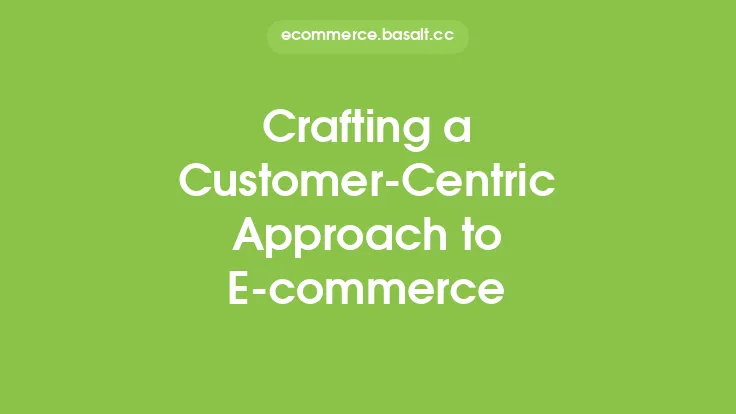In today's digital age, customers expect a seamless and consistent shopping experience across all channels, whether it's online, offline, or through mobile devices. This is where omnichannel e-commerce comes in – a business model that aims to provide a unified and integrated customer experience across all touchpoints. By adopting an omnichannel approach, e-commerce businesses can increase customer satisfaction, loyalty, and ultimately, drive revenue growth.
What is Omnichannel E-commerce?
Omnichannel e-commerce refers to the integration of all sales channels, including online marketplaces, social media, physical stores, and mobile apps, to provide a cohesive and personalized customer experience. This approach recognizes that customers interact with brands through multiple channels and devices, and that each interaction should be consistent and seamless. Omnichannel e-commerce involves creating a single, unified view of the customer across all channels, allowing businesses to provide personalized recommendations, offers, and services that meet their individual needs.
Benefits of Omnichannel E-commerce
The benefits of adopting an omnichannel e-commerce strategy are numerous. Some of the key advantages include:
- Increased customer satisfaction: By providing a seamless and consistent experience across all channels, businesses can increase customer satisfaction and loyalty.
- Improved customer retention: Omnichannel e-commerce helps businesses to build strong relationships with customers, reducing the likelihood of churn and increasing customer retention.
- Increased revenue: By providing a unified view of the customer, businesses can offer personalized recommendations and offers, driving revenue growth and increasing average order value.
- Enhanced customer insights: Omnichannel e-commerce provides businesses with a single, unified view of the customer, allowing them to gain valuable insights into customer behavior and preferences.
Key Components of Omnichannel E-commerce
To implement an effective omnichannel e-commerce strategy, businesses need to focus on several key components, including:
- Integration: Integrating all sales channels, including online marketplaces, social media, physical stores, and mobile apps, to provide a cohesive and personalized customer experience.
- Data management: Creating a single, unified view of the customer across all channels, allowing businesses to provide personalized recommendations and offers.
- Customer service: Providing consistent and high-quality customer service across all channels, including online, offline, and mobile.
- Inventory management: Managing inventory levels across all channels, ensuring that customers can access products whenever and wherever they want.
- Payment and shipping: Providing flexible payment and shipping options, including in-store pickup, curbside delivery, and same-day shipping.
Challenges of Implementing Omnichannel E-commerce
While the benefits of omnichannel e-commerce are clear, implementing an effective strategy can be challenging. Some of the key challenges include:
- Integration complexity: Integrating multiple sales channels and systems can be complex and time-consuming.
- Data management: Creating a single, unified view of the customer across all channels requires significant data management capabilities.
- Customer service: Providing consistent and high-quality customer service across all channels can be difficult, particularly in large and complex organizations.
- Inventory management: Managing inventory levels across all channels can be challenging, particularly in organizations with multiple warehouses and distribution centers.
Best Practices for Implementing Omnichannel E-commerce
To overcome the challenges of implementing omnichannel e-commerce, businesses should follow several best practices, including:
- Start small: Begin by integrating a few sales channels and gradually expand to other channels.
- Focus on customer experience: Prioritize customer experience and ensure that all interactions are consistent and seamless.
- Invest in data management: Create a single, unified view of the customer across all channels, using data management tools and technologies.
- Provide flexible payment and shipping options: Offer flexible payment and shipping options, including in-store pickup, curbside delivery, and same-day shipping.
- Monitor and measure performance: Continuously monitor and measure performance across all channels, using metrics such as customer satisfaction, retention, and revenue growth.
Technology and Tools for Omnichannel E-commerce
To implement an effective omnichannel e-commerce strategy, businesses need to leverage a range of technologies and tools, including:
- E-commerce platforms: Platforms such as Shopify, Magento, and BigCommerce provide the foundation for omnichannel e-commerce, allowing businesses to manage multiple sales channels and integrate with other systems.
- Customer relationship management (CRM) systems: CRM systems such as Salesforce and HubSpot provide a single, unified view of the customer across all channels, allowing businesses to provide personalized recommendations and offers.
- Inventory management systems: Inventory management systems such as TradeGecko and Zoho Inventory help businesses to manage inventory levels across all channels, ensuring that customers can access products whenever and wherever they want.
- Payment and shipping gateways: Payment and shipping gateways such as PayPal and ShipStation provide flexible payment and shipping options, including in-store pickup, curbside delivery, and same-day shipping.
Future of Omnichannel E-commerce
The future of omnichannel e-commerce is exciting and rapidly evolving. Some of the key trends and developments include:
- Artificial intelligence (AI) and machine learning (ML): AI and ML technologies are being used to provide personalized recommendations and offers, and to improve customer service.
- Internet of Things (IoT): IoT technologies are being used to connect physical products and devices, providing new opportunities for omnichannel e-commerce.
- Augmented reality (AR) and virtual reality (VR): AR and VR technologies are being used to create immersive and interactive shopping experiences, blurring the lines between online and offline channels.
- Social commerce: Social media platforms are becoming increasingly important for e-commerce, with businesses using social media to engage with customers, provide customer service, and drive sales.





